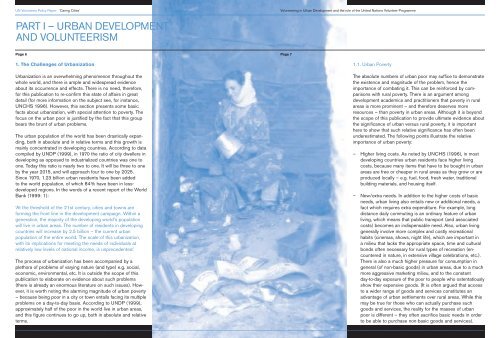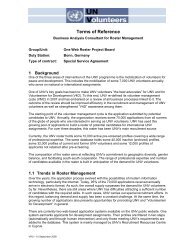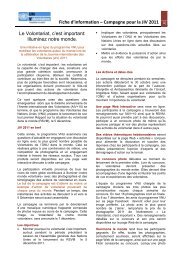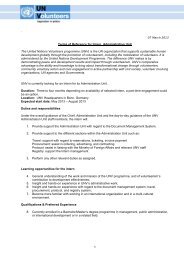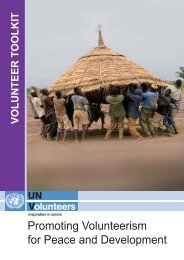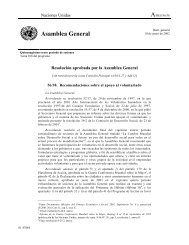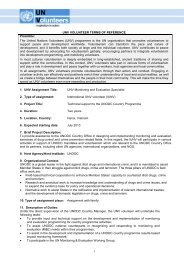View associated PDF document - United Nations Volunteers
View associated PDF document - United Nations Volunteers
View associated PDF document - United Nations Volunteers
Create successful ePaper yourself
Turn your PDF publications into a flip-book with our unique Google optimized e-Paper software.
UN <strong>Volunteers</strong> Policy Paper<br />
‘Caring Cities’<br />
Volunteering in Urban Development and the role of the <strong>United</strong> <strong>Nations</strong> Volunteer Programme<br />
PART I – URBAN DEVELOPMENT<br />
AND VOLUNTEERISM<br />
Page 6<br />
Page 7<br />
1. The Challenges of Urbanization<br />
Urbanization is an overwhelming phenomenon throughout the<br />
whole world, and there is ample and widespread evidence<br />
about its occurrence and effects. There is no need, therefore,<br />
for this publication to re-confirm this state of affairs in great<br />
detail (for more information on the subject see, for instance,<br />
UNCHS 1996). However, this section presents some basic<br />
facts about urbanization, with special attention to poverty. The<br />
focus on the urban poor is justified by the fact that this group<br />
bears the brunt of urban problems.<br />
The urban population of the world has been drastically expanding,<br />
both in absolute and in relative terms and this growth is<br />
mainly concentrated in developing countries. According to data<br />
compiled by UNDP (1999), in 1970 the ratio of city dwellers in<br />
developing as opposed to industrialized countries was one to<br />
one. Today this ratio is nearly two to one. It will be three to one<br />
by the year 2015, and will approach four to one by 2025.<br />
Since 1970, 1.23 billion urban residents have been added<br />
to the world population, of which 84% have been in lessdeveloped<br />
regions. In the words of a recent report of the World<br />
Bank (1999: 1):<br />
‘At the threshold of the 21st century, cities and towns are<br />
forming the front line in the development campaign. Within a<br />
generation, the majority of the developing world’s population<br />
will live in urban areas. The number of residents in developing<br />
countries will increase by 2.5 billion – the current urban<br />
population of the entire world. The scale of this urbanization,<br />
with its implications for meeting the needs of individuals at<br />
relatively low levels of national income, is unprecedented.’<br />
The process of urbanization has been accompanied by a<br />
plethora of problems of varying nature (and type) e.g. social,<br />
economic, environmental, etc. It is outside the scope of this<br />
publication to elaborate on evidence about such problems<br />
(there is already an enormous literature on such issues). However,<br />
it is worth noting the alarming magnitude of urban poverty<br />
– because being poor in a city or town entails facing its multiple<br />
problems on a day-to-day basis. According to UNDP (1999),<br />
approximately half of the poor in the world live in urban areas,<br />
and this figure continues to go up, both in absolute and relative<br />
terms.<br />
1.1. Urban Poverty<br />
The absolute numbers of urban poor may suffice to demonstrate<br />
the existence and magnitude of the problem, hence the<br />
importance of combating it. This can be reinforced by comparisons<br />
with rural poverty. There is an argument among<br />
development academics and practitioners that poverty in rural<br />
areas is more prominent – and therefore deserves more<br />
resources – than poverty in urban areas. Although it is beyond<br />
the scope of this publication to provide ultimate evidence about<br />
the significance of urban versus rural poverty, it is important<br />
here to show that such relative significance has often been<br />
underestimated. The following points illustrate the relative<br />
importance of urban poverty:<br />
– Higher living costs. As noted by UNCHS (1996), in most<br />
developing countries urban residents face higher living<br />
costs, because many items that have to be bought in urban<br />
areas are free or cheaper in rural areas as they grow or are<br />
produced locally – e.g. fuel, food, fresh water, traditional<br />
building materials, and housing itself.<br />
– New/extra needs. In addition to the higher costs of basic<br />
needs, urban living also entails new or additional needs, a<br />
fact which requires extra expenditure. For example, long<br />
distance daily commuting is an ordinary feature of urban<br />
living, which means that public transport (and <strong>associated</strong><br />
costs) becomes an indispensable need. Also, urban living<br />
generally involve more complex and costly recreational<br />
habits (cinemas, shows, night life), which are important in<br />
a milieu that lacks the appropriate space, time and cultural<br />
bonds often necessary for rural types of recreation (encountered<br />
in nature, in extensive village celebrations, etc.).<br />
There is also a much higher pressure for consumption in<br />
general (of non-basic goods) in urban areas, due to a much<br />
more aggressive marketing milieu, and to the constant<br />
day-to-day exposure of the poor to people who ostentatiously<br />
show their expensive goods. (It is often argued that access<br />
to a wider range of goods and services constitutes an<br />
advantage of urban settlements over rural areas. While this<br />
may be true for those who can actually purchase such<br />
goods and services, the reality for the masses of urban<br />
poor is different – they often sacrifice basic needs in order<br />
to be able to purchase non-basic goods and services).


